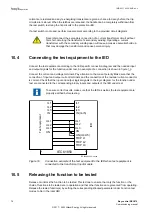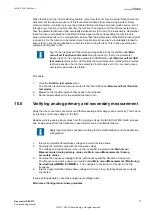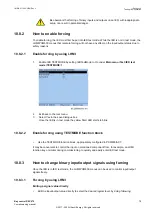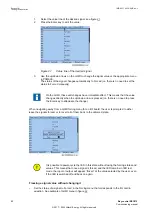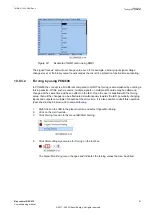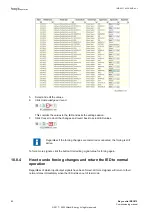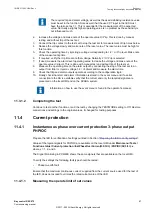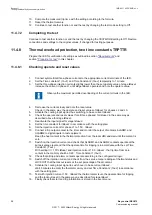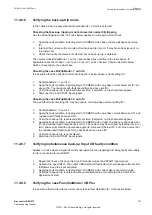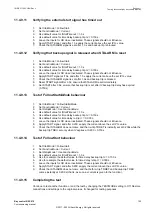
1.
Connect the test set for current injection to the appropriate IED phases.
If there is any configuration logic that is used to enable or block any of the four available
overcurrent steps, make sure that the step under test is enabled (for example, end fault
protection).
If
1 out of 3
currents are chosen for operation: Connect the injection current to phases L1 and
neutral.
If
2 out of 3
currents are chosen for operation: Connect the injection current into phase L1 and
out from phase L2.
If
3 out of 3
currents are chosen for operation: Connect the symmetrical three-phase injection
current into phases L1, L2 and L3.
2.
Connect the test set for the appropriate three-phase voltage injection to the IED phases L1, L2
and L3. The protection shall be fed with a symmetrical three-phase voltage.
3.
Block higher set stages when testing lower set stages by following the procedure described
below:
3.1. Set the injected polarizing voltage larger than the set minimum polarizing voltage (default
is 5% of
UBase
) and set the injection current to lag the appropriate voltage by an angle of
about 80° if forward directional function is selected.
If
1 out of 3
currents are chosen for operation: The voltage angle of phase L1 is the
reference.
If
2 out of 3
currents are chosen for operation: The phase angle of the phase-to-phase
voltage L1L2 is the reference for L1Phase.
If
3 out of 3
currents are chosen for operation: The voltage angle of phase L1 is the
reference.
If reverse directional function is selected, set the injection current to lag the polarizing
voltage by an angle equal to 260° (equal to 80° + 180°).
3.2. Increase the injected current, note the operate value of the tested step of the function
and compare it to the set value.
3.3. Decrease the current slowly, note the reset value and compare it to the reset ratio 95%.
4.
If the test has been performed by injection of current in phase L1, repeat the test, injecting
current into phases L2 and L3 with polarizing voltage connected to phases L2, respectively L3
(
1 out of 3
currents for operation).
5.
If the test has been performed by injection of current in phases L1 – L2, repeat the test,
injecting current into phases L2 – L3 and L3 – L1 with the appropriate phase angle of injected
currents.
6.
Connect a trip output contact to a timer.
7.
Set the injected current to 200% of the operate level of the tested stage, switch on the current
and check the time delay.
For inverse time curves, check the operate time at a current equal to 110% of the operate
current for
txMin
.
8.
Check that all operate and start contacts operate according to the configuration (signal
matrixes).
9.
Reverse the direction of the injected current and check that the protection does not operate.
10.
If
2 out of 3
or
3 out of 3
currents are chosen for operation: Check that the function will not
operate with current in one phase only.
11.
Repeat the above described tests for the higher set stages.
12.
Check that start and trip information is stored in the event menu .
11.4.2.3
Completing the test
SEMOD56287-118 v4
Continue to test another function or end the test by changing the
TESTMODE
setting to
Off
. Restore
connections and settings to the original values, if changed for testing purposes.
11.4.3
Instantaneous residual overcurrent protection EFPIOC
SEMOD52967-3 v7
Prepare the IED for verification of settings outlined in Section
"Preparing the IED to verify settings"
1MRK 511 403-UEN Rev. L
Section 11
Testing functionality by secondary injection
Bay control REC670
89
Commissioning manual
© 2017 - 2022 Hitachi Energy. All rights reserved
Summary of Contents for REC670
Page 1: ...Relion 670 SERIES Bay control REC670 Version 2 2 IEC Commissioning manual ...
Page 2: ......
Page 28: ...22 ...
Page 54: ...48 ...
Page 60: ...54 ...
Page 66: ...60 ...
Page 90: ...84 ...
Page 212: ...206 ...
Page 218: ...212 ...
Page 232: ...226 ...
Page 240: ...234 ...
Page 241: ...235 ...


